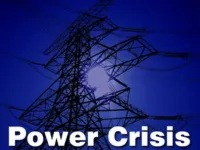
China faces worst-ever power shortage
Shuai Jungin, State Grid Corporation of China executive vice president, warns that China will face its worst-ever power shortage this summer.
Droughts have cut 22% of China’s hydro-electric power generation, while prices for domestic coal have risen by up to 10% this year, without a comparable increase in on-grid tariff prices. Coal-fired power plants account for close to 75% of China’s generating capacity.
Rising coal costs are credit negative for China Resources Power and most other utilities, many of which will stem widening financial losses from rising fuel prices by idling some capacity this summer under the guise of "major maintenance repair". However, in the case of CR Power, it may be able to mitigate the impact by capitalizing on the weaker position of its domestic competitors.
With its power plants mostly located in China’s most developed eastern area, its higher-than-average operation efficiency and a capacity utilization rate that consistently hovers 20% above the national average, CR Power has managed to remain profitable at a time of increasing stress, not just for Chinese utilities, but also for those in other Asian countries that lack automatic cost-pass-through mechanisms. CR Power’s coal mines, which produce about 25% of its coal consumption, also mitigate pressures on its margins from rising fuel prices.
Thermal coal prices have nearly tripled over the past five years, while the on-grid tariff, which is controlled by the government, has been raised by roughly one third over the same period. The state increased the on-grid tariff by an average of only RMB1.2 cents or around 3% in April, the first tariff adjustment since 2008. With annual inflation above 5% (and well above the government’s targeted 3% range) sufficient tariff relief to squeezed utilities is unlikely.
Chinese authorities do not want to burden consumers by raising prices for yet another daily necessity.
With summer approaching and modern China’s most severe power shortage looming large, the authorities will be inclined to direct state-owned power plants to raise coal inventory levels, a move that will push coal prices even higher.
Between the hydro-electric shortages and idled capacity at many coal-fired utilities, the country faces a power shortage that could surpass the 30-million-kwh record shortfall of 2004 (equivalent to the electricity output of a mid-sized province like Anhui or Hunan), Mr. Shuai said.
And, if droughts and extreme weather problems worsen, at least 26 provinces would be affected, with Jiangsu, Guangdong, and Zhejiang provinces facing the largest shortages. However, while other utilities have tried to idle capacity to stem their losses for every kilowatt generated, CR Power still has the potential to increase utilization to take advantage of the higher demand.



![SBR 5 Lorem Ipsum News 2 [8 May]](https://cmg-qa.s3.ap-southeast-1.amazonaws.com/s3fs-public/styles/exclusive_featured_article/public/2025-05/a_hand_pointing_to_a_futuristic_technology_5b87c9d0e3_3.png.webp?itok=M3Hf-9XR)
![SBR 4 Lorem Ipsum [8 May Top Stories]](https://cmg-qa.s3.ap-southeast-1.amazonaws.com/s3fs-public/styles/exclusive_featured_article/public/2025-05/a_hand_pointing_to_a_futuristic_technology_5b87c9d0e3_2.png.webp?itok=2m5Wl0MX)


![Exclusive three SBR 12 Lorem Ipsum [8 May]](https://cmg-qa.s3.ap-southeast-1.amazonaws.com/s3fs-public/styles/exclusive_featured_article/public/2025-05/a_hand_pointing_to_a_futuristic_technology_5b87c9d0e3_11.png.webp?itok=8kn_UIfA)
![SBR 3 Lorem Ipsum [ Exclusive 2]](https://cmg-qa.s3.ap-southeast-1.amazonaws.com/s3fs-public/styles/exclusive_featured_article/public/2025-05/a_hand_pointing_to_a_futuristic_technology_5b87c9d0e3_1.png.webp?itok=YCyjLegJ)
![SBR 2 Lorem Ipsum [8 May]](https://cmg-qa.s3.ap-southeast-1.amazonaws.com/s3fs-public/styles/exclusive_featured_article/public/2025-05/a_hand_pointing_to_a_futuristic_technology_5b87c9d0e3_0.png.webp?itok=_cKD-29o)

![Video [Event News]](https://cmg-qa.s3.ap-southeast-1.amazonaws.com/s3fs-public/styles/event_news_featured_article/public/2025-05/screenshot-2025-05-08-at-4.58.53-pm_0.png.webp?itok=Kud35sMs)
![Event News SBR 9 Lorem Ipsum [8 may]](https://cmg-qa.s3.ap-southeast-1.amazonaws.com/s3fs-public/styles/event_news_thumbnail/public/2025-05/a_hand_pointing_to_a_futuristic_technology_5b87c9d0e3_8.png.webp?itok=DTh_dbYp)
![Event News SBR 9 Lorem Ipsum [8 May]](https://cmg-qa.s3.ap-southeast-1.amazonaws.com/s3fs-public/styles/event_news_thumbnail/public/2025-05/a_hand_pointing_to_a_futuristic_technology_5b87c9d0e3_7.png.webp?itok=vzDAzb6V)
![Event News SBR 8 Lorem Ipsum [8 May]](https://cmg-qa.s3.ap-southeast-1.amazonaws.com/s3fs-public/styles/event_news_thumbnail/public/2025-05/a_hand_pointing_to_a_futuristic_technology_5b87c9d0e3_6.png.webp?itok=jvHFc4P6)
![Video [Event News]](https://cmg-qa.s3.ap-southeast-1.amazonaws.com/s3fs-public/styles/video_thumbnail/public/2025-05/screenshot-2025-05-08-at-4.58.53-pm_0.png.webp?itok=yZnI0YBb)
![Video 1 SBR [8 May]](https://cmg-qa.s3.ap-southeast-1.amazonaws.com/s3fs-public/styles/video_thumbnail/public/2025-05/screenshot-2025-05-08-at-4.58.53-pm.png.webp?itok=9AAeRz_k)

 Advertise
Advertise

